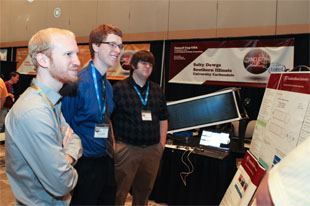
Cornell Cup 2013: A Year in Reflection at Southern Illinois University
August 31, 2013

A team of five undergraduates from the Department of Electrical and Computer Engineering at Southern Illinois University Carbondale recently returned from the second annual Cornell Cup with an Honorable Mention. Sponsored by Intel and organized by Cornell University, the Cornell Cup is an embedded design competition that asks teams of three to five college students to research a real problem and propose a solution that involves the innovative application of embedded technology – computer systems designed to control specific mechanical or electrical systems.
The team of Daniel Olsen, Steven Blair, Chase Cooley, Jessica Suda, and Nick Turner first became interested in the competition after discussing the need for a method accessible to businesses, organizations, and researchers alike to cheaply and efficiently gather large amounts of data in a variety of water sources. Seeking a device that could be used for such diverse purposes as monitoring the health of aquatic ecosystems, ensuring the quality of water in municipal reservoirs, and checking for the presence of contraband on seafaring ship hulls, the team imagined an autonomous underwater vehicle that could enable prolonged, difficult, and monotonous missions by removing the need for human interaction. Powered by batteries, the vehicle would resemble a submarine while underwater and be capable of self-navigation between preset waypoints using global positioning satellites and a variety of sensors. When low on power, the vehicle would be capable of flipping up like a buoy at the surface of the water and charging by the use of flexible solar panels mounted on the side.
Fleshing out their idea in an application that required critical analysis of both the industry needs that had to be satisfied by a successful product and the industry practices that would best accomplish those requirements, the team submitted a report judged against others from universities across the nation by representatives from top technology companies. Taking on the name of the “Salty Dawgs,” the team from Southern Illinois University was one of thirty teams to survive the final cut on the basis of the novelty and practicality of their challenge and solution and received the funding and materials from Intel, the College of Engineering at SIUC, and the Department of Electrical and Computer Engineering at SIUC needed to transform their dream into a reality.
Throughout the following year the students committed to an undertaking guided by Dr. Ning Weng and graduate student Luke Pierce that led them from the detailed design of the solution through implementation, testing, and revision of the final product. The students’ work culminated in a two-day summit held at Walt Disney World on May 3 and 4 where teams presented their work for final judging, met industry leaders, and participated in seminars and educational meetings. The team’s dedication was represented in paper, poster, and slideshow presentations with hope directed to taking home the grand prizes of $10,000, $5,000, and $2,500 that were distributed to the top three teams. Competition included the likes of the University of Pennsylvania which brought an upper body exoskeleton that could be used in rehabilitation, Worcester Polytechnic Institute which presented a wheelchair equipped with sensors capable of reading brain waves that could be controlled by those suffering from full-body paralysis, and the University of Colorado Denver which developed an inexpensive system of networked cell phone antennas that could be used to extend local reception.
In the end the team from Southern Illinois University was presented with an Honorable Mention at the award ceremony held in the American Heritage Gallery at Epcot that capped off a year in which five students received invaluable practical experience in the entire engineering process and paved the way for future students to get involved in the competition. Even more importantly, though, the team demonstrated just how supportive the members of both the university and the community are. Without funding from Intel, the College of Engineering at SIUC, and the Department of Electrical and Computer Engineering at SIUC none of it would have been possible, and without the patience and assistance of Dr. Spyros Tragoudas, Dr. Ning Weng, Luke Pierce, Laura Anz, Gladys Hounsinou, Dr. Bruce DeRuntz, Tim Baxter, and Jack and Jane Childers none of it would have been successful. For that reason, the team is thankful for everyone involved in taking the project from little more than a concept to an invaluable and unforgettable experience.
